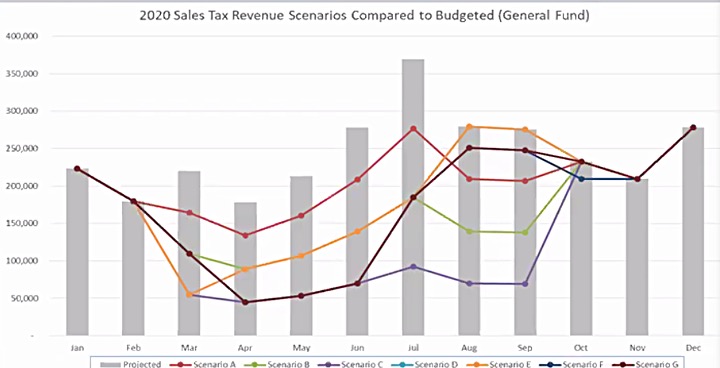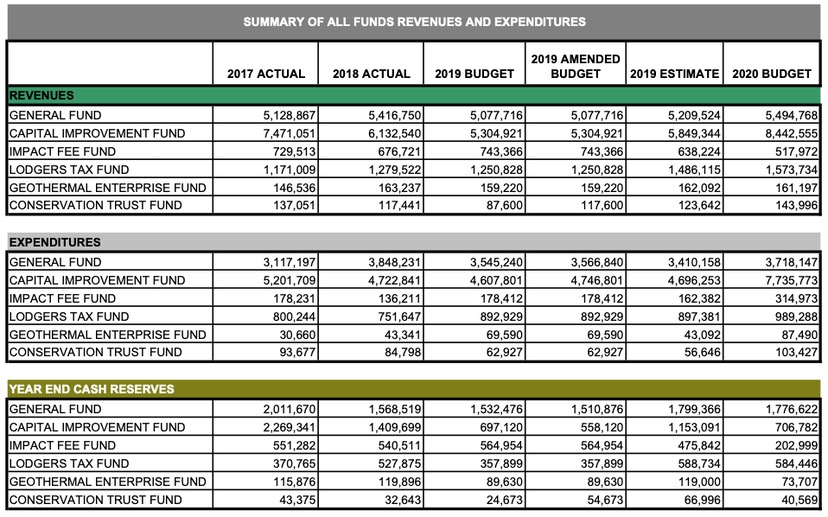Back in the late 1970s, I spent a few years as a builder of musical instruments, and I learned the importance of sharp tools. Not only do sharp chisels and knives and saws and other cutting tools make for more enjoyable work, they’re safer to use. A blunt knife does not always follow the intended cutting line, and that fact can have unpleasant consequences for the person wielding it.
Discovering how to properly sharpen my tools presented nearly as steep a learning curve as did the construction of the various instruments I was building.
I wrote yesterday about the online work session held by the Pagosa Springs Town Council on March 26, and about Resolution 2020-01 — the Town’s policy that requires staff to cut back on expenditures whenever there’s a documented, comparative drop in sales tax collections of more than 5%. This policy might be a useful tool for preserving the Town’s fiscal sanity, but the graph that Town Manager Andrea Phillips discussed at the work session was (in my humble opinion) not only blunt but possibly useless.

To help the Town Council understand the possible effects of the COVID-10 crisis on municipal sales tax collections, the Town staff had prepared this graph to show seven possible projections of a drop in sales tax collections, ranging from mild to severe, and lasting anywhere from five to seven months.
Do any of the seven colored lines represent anything close to Town’s future revenues?
Due to the consistent delay in getting sales tax figures from the Colorado Department of Revenue, the Town won’t know how the month of February turned out until the middle of April — and won’t know how April turned out until the mid-June. Many factors remain unclear. Will our second homes owners be coming back to Pagosa this summer? Will we see any tourists this year? Will businesses be allowed to re-open in April, or May? Will our limited supply of qualified employees move away, looking for work elsewhere? Will the entire national economy melt down?
We have no idea.
Ms. Phillips:
“With all that said, it’s very challenging for us to provide a true projection for you right now. But we think we’re going to see a decline — maybe as little as 15%, but it could be as much as 30%. I hope we don’t get to that 45% scenario…”
How Town staff picked this particular range of choices for its graph wasn’t clear to me, listening to the March 26 presentation. Knowing that the Town… and the nation… and the whole world… have never been in a situation like the one we’re facing at the moment, it’s not only “very challenging” to offer a “true projection”… it’s quite simply impossible.
So why pretend?

Meanwhile, the Town has been planning for a financial crisis like this since 2009, by building up several large reserve accounts — saving for a rainy day, so to speak. When I look over the Town’s 2020 budget, the Year-End Cash Reserves appeared to total over $4 million at the end of 2019. I realize the municipal government has committed itself to a brand new, multi-million-dollar Town Shop facility, but even at the end of 2020, the budget projections show $3.4 million in Cash Reserves remaining.

What should a municipal government do with a rather large amount of savings, in our current situation? If we assume that 2020 would be a good time to come up with some inventive ways to benefit a struggling community…
It appears that, according to Resolution 2020-01, the Town staff will be required to cut back on budgeted expenditures if sales tax collections drop — which in turn implies that the reserve funds would not be needed to keep the Town operating — because spending will be adjusted to match tax revenues. In such case, dear reader, how would you want the Town to spend a portion of its reserves, in this emergency situation? Assuming you agree with the idea of doing something ‘outside the box’?
Several non-profit organizations have stepped up, in Colorado, to raise donations and funnel money into beneficial endeavors. The state of Colorado has joined forces with Mile High United Way to form the Colorado COVID-19 Relief Fund, which raised $2.8 million during its first two days of operation, including hefty donations from the Colorado Health Foundation, and from the owners of the Denver Broncos.
Here in southwest Colorado, the Community Foundation Serving Southwest Colorado has activated a Community Emergency Relief Fund, which aims to help “the most vulnerable members of our community.” These resources will be disbursed as needed and as available, says the Foundation. Community stakeholders, including representatives from public health, local governments, school districts, businesses and nonprofits will prioritize available funds to meet immediate needs in our region, including public health needs and economic impacts.
American businesses are stepping up to contribute. Last week, for example, Google announced an $800 million pledge to support businesses and health organizations fighting the coronavirus. Part of that pledge includes donating “2-3 million face masks” to the CDC Foundation. In a blog post, Google CEO Sundar Pichai announced that the company is working with supplier Magid Glove & Safety to ramp up production of masks in the coming weeks. The post also detailed the larger effort by Google to donate both cash and ads to help support small- and medium-sized businesses, health organizations, and academic institutions.
Whether these helpful efforts will reach people in Archuleta County remains to be seen. To date, the actual virus has yet to make a significant impact on the Pagosa Springs health care system. The effects of the Polis administration’s “Stay At Home” orders and business closures, meanwhile, have been felt in every corner of the community.
We probably could use some locally-sourced, locally-distributed help.
Can the Town government find any tools in its toolbox… that aren’t too blunt?
